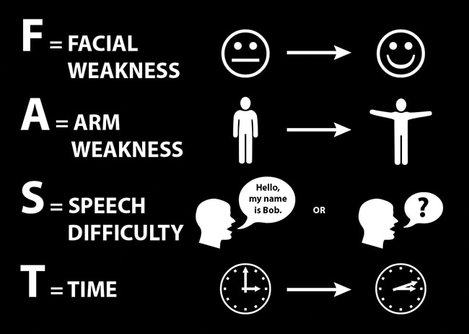I love having this post as a forum to share important information about science, medicine, and health. And so, to help me cope with an event of this past December, I’m sharing with you a simple test that everyone should know and is easy to perform. My niece knew it, and for that she was able to save a life.
This test is called FAST, and it’s an acronym for F-ace, A-rm, S-peech, and T-ime. This simple test is what you perform on someone when you suspect they are having a stroke. But to back up, let’s quickly review what a stroke is, and what symptoms would clue you off to someone experiencing a stroke.
First, a stroke describes what happens when the brain has been oxygen-deprived, and tissue damage has begun to occur. Once tissue damage becomes significant, a myriad of problems can occur: speech becomes slurred, incomprehensible (words aren't pronounced properly) or doesn’t make sense (words jumbled together), the person becomes unresponsive to questions, eyes cannot track movement or the person reports distorted vision, odd repetitive movements of the head occur, lack of mobility in the body (like the arms) happens, and even visible changes in facial structure (a drooping corner of the mouth, or a whole side of a face is slack) are seen.
Oxygen deprivation can also occur in many ways. The most familiar one is that a clot has broken off from the wall of an artery (vessel that carries oxygen-rich blood from the heart to the rest of the body) from where it formed, traveled through the heart, the lungs, and finally lodges in a smaller vessel that leads to the brain. From there, it cuts off the oxygen-rich blood to the brain, and that is how the brain tissue starts to get damaged.
A lesser known cause is that a vessel that drains the oxygen-depleted blood, called a vein (vessel that brings blood back to the heart for oxygenation), can get clogged by a clot as well. This occurrence is actually extremely rare, and so although the brain is able to receive oxygen-rich blood, the oxygen-depleted blood cannot drain away. And when it has nowhere to go, it floods the brain tissue, which, if you can imagine, is somewhat akin to the tissue getting drowned in excess fluid. Thus the same thing results: the tissue starts to get damaged.
So, a very quick and easy test to know and perform on someone who might be exhibiting some of the symptoms mentioned above, is the FAST test. You can ask the questions in the following way:
“Can you smile?” or “Show me your teeth!”
“Can you close your eyes and raise your arms?” or “Raise your arms!”
“What is your name? How old are you? What’s your address?” or “Can you repeat this sentence, ”The weather sure is cloudy today!”
If the person fails these tests, CALL 9-1-1 ASAP. Don’t hesitate, because the more time the brain tissue is damaged, the less of a chance it has to undo the damage and recover. Because it can, and it will, if we act FAST.
This test is called FAST, and it’s an acronym for F-ace, A-rm, S-peech, and T-ime. This simple test is what you perform on someone when you suspect they are having a stroke. But to back up, let’s quickly review what a stroke is, and what symptoms would clue you off to someone experiencing a stroke.
First, a stroke describes what happens when the brain has been oxygen-deprived, and tissue damage has begun to occur. Once tissue damage becomes significant, a myriad of problems can occur: speech becomes slurred, incomprehensible (words aren't pronounced properly) or doesn’t make sense (words jumbled together), the person becomes unresponsive to questions, eyes cannot track movement or the person reports distorted vision, odd repetitive movements of the head occur, lack of mobility in the body (like the arms) happens, and even visible changes in facial structure (a drooping corner of the mouth, or a whole side of a face is slack) are seen.
Oxygen deprivation can also occur in many ways. The most familiar one is that a clot has broken off from the wall of an artery (vessel that carries oxygen-rich blood from the heart to the rest of the body) from where it formed, traveled through the heart, the lungs, and finally lodges in a smaller vessel that leads to the brain. From there, it cuts off the oxygen-rich blood to the brain, and that is how the brain tissue starts to get damaged.
A lesser known cause is that a vessel that drains the oxygen-depleted blood, called a vein (vessel that brings blood back to the heart for oxygenation), can get clogged by a clot as well. This occurrence is actually extremely rare, and so although the brain is able to receive oxygen-rich blood, the oxygen-depleted blood cannot drain away. And when it has nowhere to go, it floods the brain tissue, which, if you can imagine, is somewhat akin to the tissue getting drowned in excess fluid. Thus the same thing results: the tissue starts to get damaged.
So, a very quick and easy test to know and perform on someone who might be exhibiting some of the symptoms mentioned above, is the FAST test. You can ask the questions in the following way:
“Can you smile?” or “Show me your teeth!”
“Can you close your eyes and raise your arms?” or “Raise your arms!”
“What is your name? How old are you? What’s your address?” or “Can you repeat this sentence, ”The weather sure is cloudy today!”
If the person fails these tests, CALL 9-1-1 ASAP. Don’t hesitate, because the more time the brain tissue is damaged, the less of a chance it has to undo the damage and recover. Because it can, and it will, if we act FAST.


 RSS Feed
RSS Feed
